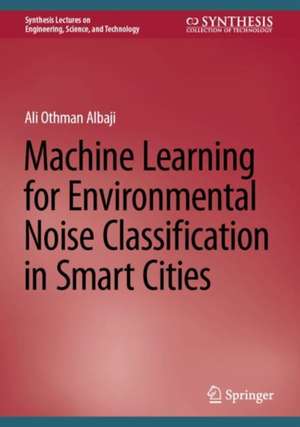Machine Learning for Environmental Noise Classification in Smart Cities: Synthesis Lectures on Engineering, Science, and Technology
Autor Ali Othman Albajien Limba Engleză Hardback – 23 mar 2024
Din seria Synthesis Lectures on Engineering, Science, and Technology
-
 Preț: 393.52 lei
Preț: 393.52 lei -
 Preț: 395.92 lei
Preț: 395.92 lei -
 Preț: 321.34 lei
Preț: 321.34 lei -
 Preț: 284.04 lei
Preț: 284.04 lei - 15%
 Preț: 500.59 lei
Preț: 500.59 lei -
 Preț: 397.38 lei
Preț: 397.38 lei - 15%
 Preț: 581.14 lei
Preț: 581.14 lei -
 Preț: 387.75 lei
Preț: 387.75 lei -
 Preț: 320.40 lei
Preț: 320.40 lei - 20%
 Preț: 594.83 lei
Preț: 594.83 lei -
 Preț: 384.86 lei
Preț: 384.86 lei - 20%
 Preț: 588.21 lei
Preț: 588.21 lei - 18%
 Preț: 738.28 lei
Preț: 738.28 lei - 15%
 Preț: 644.95 lei
Preț: 644.95 lei -
 Preț: 329.98 lei
Preț: 329.98 lei -
 Preț: 214.57 lei
Preț: 214.57 lei -
 Preț: 236.41 lei
Preț: 236.41 lei - 20%
 Preț: 331.25 lei
Preț: 331.25 lei -
 Preț: 320.40 lei
Preț: 320.40 lei - 15%
 Preț: 527.97 lei
Preț: 527.97 lei -
 Preț: 420.97 lei
Preț: 420.97 lei - 15%
 Preț: 583.61 lei
Preț: 583.61 lei -
 Preț: 352.63 lei
Preț: 352.63 lei - 15%
 Preț: 527.97 lei
Preț: 527.97 lei -
 Preț: 420.02 lei
Preț: 420.02 lei - 15%
 Preț: 526.35 lei
Preț: 526.35 lei -
 Preț: 396.43 lei
Preț: 396.43 lei - 18%
 Preț: 735.07 lei
Preț: 735.07 lei -
 Preț: 270.36 lei
Preț: 270.36 lei -
 Preț: 386.81 lei
Preț: 386.81 lei - 20%
 Preț: 295.74 lei
Preț: 295.74 lei - 17%
 Preț: 458.17 lei
Preț: 458.17 lei - 15%
 Preț: 523.91 lei
Preț: 523.91 lei -
 Preț: 514.29 lei
Preț: 514.29 lei -
 Preț: 413.76 lei
Preț: 413.76 lei -
 Preț: 404.13 lei
Preț: 404.13 lei -
 Preț: 427.71 lei
Preț: 427.71 lei -
 Preț: 390.63 lei
Preț: 390.63 lei -
 Preț: 358.76 lei
Preț: 358.76 lei - 15%
 Preț: 640.06 lei
Preț: 640.06 lei -
 Preț: 399.81 lei
Preț: 399.81 lei -
 Preț: 221.18 lei
Preț: 221.18 lei - 15%
 Preț: 531.26 lei
Preț: 531.26 lei - 15%
 Preț: 528.80 lei
Preț: 528.80 lei - 15%
 Preț: 529.60 lei
Preț: 529.60 lei
Preț: 389.70 lei
Nou
Puncte Express: 585
Preț estimativ în valută:
74.59€ • 81.05$ • 62.70£
74.59€ • 81.05$ • 62.70£
Carte disponibilă
Livrare economică 31 martie-14 aprilie
Preluare comenzi: 021 569.72.76
Specificații
ISBN-13: 9783031546662
ISBN-10: 3031546660
Pagini: 170
Ilustrații: XVII, 170 p. 134 illus., 111 illus. in color.
Dimensiuni: 168 x 240 mm
Greutate: 0.45 kg
Ediția:2024
Editura: Springer Nature Switzerland
Colecția Springer
Seria Synthesis Lectures on Engineering, Science, and Technology
Locul publicării:Cham, Switzerland
ISBN-10: 3031546660
Pagini: 170
Ilustrații: XVII, 170 p. 134 illus., 111 illus. in color.
Dimensiuni: 168 x 240 mm
Greutate: 0.45 kg
Ediția:2024
Editura: Springer Nature Switzerland
Colecția Springer
Seria Synthesis Lectures on Engineering, Science, and Technology
Locul publicării:Cham, Switzerland
Cuprins
Introduction. - Literature Review. - Research Methodology. - Results and Discussion. - Conclusion and Recommendations.
Notă biografică
Ali Othman Albaji received a bachelor’s degree in electrical engineering specializing in “General communications” from the Civil Aviation Higher College, Tripoli, Libya, in 2007, and a Master’s degree in electronics and telecommunication engineering from University Technology Malaysia *UTM*, Johor Bahru, Malaysia in 2022. His research interests are Machine Learning (ML), IoT, Wireless Sensor Networks (WSN), VSAT, SCADA Systems, Optical Networking, Wireless Communications, Deep Learning (DL), Artificial intelligence (AI), Web design, Robotics, and Programming Languages expert / Traineron ( Python, MATLAB, JAVA, JAVA Script, SQL, Data Base MSQL, C++, HTML, and....ETC).
Textul de pe ultima copertă
We present a Machine Learning (ML) approach to monitoring and classifying noise pollution. Both methods of monitoring and classification have been proven successful. MATLAB and Python code was generated to monitor all types of noise pollution from the collected data, while ML was trained to classify these data. ML algorithms showed promising performance in monitoring the different sound classes such as highways, railways, trains and birds, airports and many more. It is observed that all the data obtained by both methods can be used to control noise pollution levels and for data analytics. They can help decision making and policy making by stakeholders such as municipalities, housing authorities and urban planners in smart cities. The findings indicate that ML can be used effectively in monitoring and measurement. Improvements can be obtained by enhancing the data collection methods. The intention is to develop more ML platforms from which to construct a less noisy. The second objective of this study was to visualize and analyze the data of 18 types of noise pollution that have been collected from 16 different locations in Malaysia. All the collected data were stored in Tableau software. Through the use of both qualitative and quantitative measurements, the data collected for this project was then combined to create a noise map database that can help smart cities make informed decisions.
In addition, this book:
- Machine learning-based sound classifier for environmental noise
- Qualitative analysis of community perceptions based on a noise pollution survey
- Create an interactive web dashboard and data warehousing for intelligent analytics reporting
Caracteristici
Machine learning-based sound classifier for environmental noise Qualitative analysis of community perceptions based on a noise pollution survey Create an interactive web dashboard and data warehousing for intelligent analytics reporting
